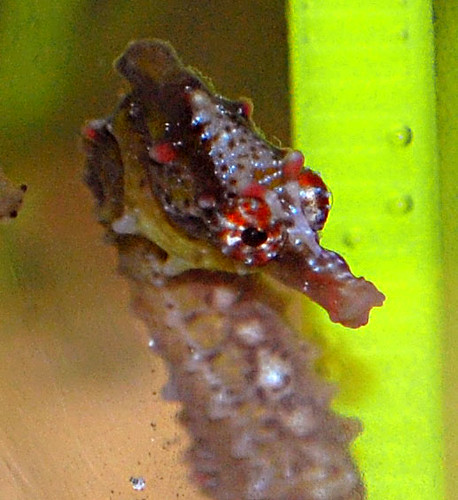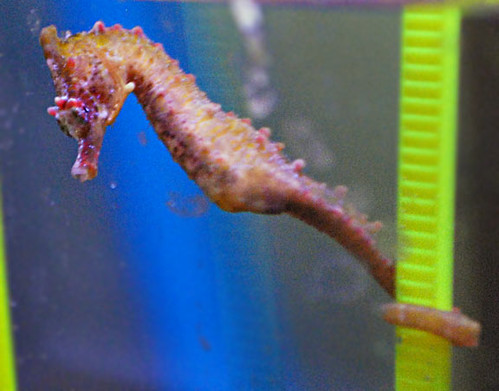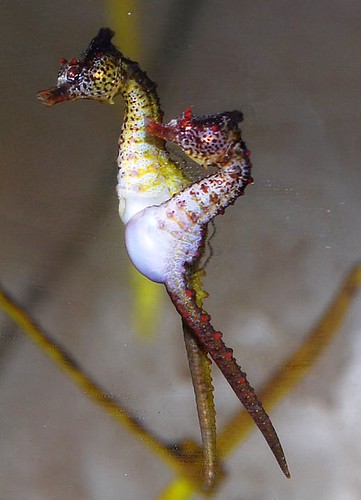One of the questions most commonly asked on seahorse.org is, "Can I keep my seahorses in a 10 gallon aquarium?" The short answer is no. None of the species currently available to hobbyists in the United States are suitable for a ten gallon tank (except a large herd of Dwarf Seahorses H. zosterae which require live Artemia feedings.)
Hippocampus tuberculatus is a small seahorse (~2-1/2") from Australia that thrives in smaller aquariums but is large enough to eat frozen mysis shrimp. They are commonly yellow and sport bumps on their bodies, tails, and faces that may turn bright red especially during courting. This species used to be lumped in with the temperate Hippocampus breviceps, but they differ in having a smaller size and coming from a warmer habitat. H. breviceps and H. tuberculatus are most closely related to the large, temperate H. abdominalis. Because all seahorses, even those that are not at risk of population reduction, were placed on the CITES list, exotic wild caught seahorses are not as readily available in the United States as captive bred seahorses. Most distributors consider importing Australian seahorse species not worth the trouble because of permit costs, shipping costs, and low survivability of wild caught seahorses. Divers don't usually collect them, but if they do, there's a good chance they will not be able to identify species or even gender.
For many years I searched for a supplier of my favorite seahorse species H. breviceps. According to Rudie Kuiter's 2009 Seahorses and their Relatives, this species is numerous in its wild Australian habitat. The species' success may be in part due to the recent drop in population of large predators. Normally this species is demersal, but in recent years, large colonies of pelagic individuals that normally could not survive predation have been seen living on sea grass mats.
Last May, friends in the industry who knew I was looking for Australian seahorses found a single pair H. breviceps on a list from a distributor. Despite the cost, I ordered them without hesitation. When they arrived, at once I realized they were both males. My dreams of breeding them were dashed! After consulting some seahorse ID experts in the US and Australia, we decided they were actually H. tuberculatus instead of the similar H. breviceps.
 |
| Notice the red bumps and white forehead triangle typical of H. tuberculatus |
I had a ten gallon chilled temperate aquarium set up for the Breviceps, but raised the temperature to 68F for the Tubercualtus (H. tuberculatus isn't fully tropical and should only briefly be exposed to higher temperatures of 75F maximum). After a couple days of acclimating to captive life, they began eating enriched live adult brine shrimp. They weren't gaining weight very easily, so they also went through a delicate but successful de-worming process. Within a month, they were eating frozen Cyclop-eeze along with the adult brine, and by the end of June were eating frozen mysis and fattened up nicely.
The most endearing thing about my two Tuberculatus that I named Lemony and Snicket was the way they "crash-landed" into a hitching post. Most seahorses swim to a hitch and wrap their tails around it to land. These Tuberculatus almost always swam at a hitch at full speed and then landed with the neck first, then body, then wrapped the tail around the hitch.
 |
| H. tuberculatus first day in his new aquarium |
My hope is that in the future the highly desirable Hippocampus tuberculatus will be collected and imported in larger numbers so captive breeding in the United States can begin and make this species available to hobbyists. This beautiful, unique species is worth the trouble because it is the perfect seahorse for most hobbyist's aquariums - small enough to fit in a 10 gallon tank but large enough to eat frozen mysis shrimp.


Felicia,
ReplyDeleteFirst, again I am so sorry for your loss. I know this must have caught you off guard. After reading your blog and looking at the pictures, this seahorse is really tiny. The tuberculatus and the breviceps is also my favorite.
I have managed to contact a vendor in Australia that is willing to ship to the United States. She is checking into getting her CITIES permit to export.
As soon as I hear from her I will notify you and the seahorse.org members.
Felecia
Yay Tubers! It's really sad that you lost them, but it does sound like there might be an opportunity to get more into the states?
ReplyDeleteI think it would be great to arrange a group of breeders and dedicated seahorse keepers to take on the challenge of creative a breeding program for them in the US.
I agree! The more breeders that are trying them, the better the chance of success.
ReplyDeleteFelecia, please let me know if your contact is able to export to the U.S. I would be extremely interested in getting more Aussie seahorses (tubers, angustus, elongatus, etc.)
Hi Felicia,
ReplyDeleteDo you have the provider that has the Knobby seahorse Hippocampus tuberculatus?
Any help is appreciated!
Cheers,
Graham